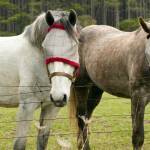Equine Vision Defect Linked to Leopard Complex Spotting Gene

Equine coat color is controlled by a number of genes that vary in dominance to produce an almost unlimited range of colors and markings. Some horse registries rely strongly on color, accepting only horses with a particular coat shade or set of markings. Likewise, flashy markings are highly favored within some riding disciplines, and breeders select mares and stallions based on the likelihood that offspring will exhibit a desired appearance.
Leopard spotting in horses is caused by an incompletely dominant gene known as LP. The gene is found in several breeds and can show up as only a few white spots that are scattered symmetrically over the hips. Other horses develop an almost completely white coat. Various expressions of LP can cause striped hooves, white sclera (tissues around the eye), and white mottling around the horse’s anus and genitals. The LP gene is also responsible for varnish roaning, a coat color pattern in which the horse becomes whiter as it ages while retaining darker coloring on the face and lower legs.
This genetic pattern has been a part of the horse’s DNA for at least 17,000 years, according to analysis of ancient equine DNA samples. Technically, the gene doesn’t cause a white coat, but instead it modifies pigmentation of some or all hairs so that a darker coat color does not develop normally. It is not known whether this condition is caused by a low number of pigment-producing cells, or melanocytes, or a loss of function in the melanocytes that are present. Melanosomes, the organelles that are responsible for the synthesis and transport of pigment, are often misshapen in affected horses, suggesting that the malfunction in color expression begins in these structures. Unfortunately, some genes and mutations related to coat color in horses and other animals are also linked to defects in other traits such as hearing and eyesight. Deafness in many blue-eyed, white-coated cats is an example. In the case of the LP gene, horses that have received a copy from each parent may have also inherited congenital stationary night blindness. Horses with this visual defect can see normally in daylight but have greatly reduced vision at night or in dim light.
The Animal Genetics laboratory can determine whether a particular horse is a carrier of the LP gene. The test can show whether a prospective sire or dam has no copies of the gene, and therefore can’t pass it on to offspring; has one copy, which it will pass to approximately half of its offspring; or has two copies, and is thus guaranteed to pass the trait to offspring. The only way to avoid passing the gene to foals is to avoid using carriers for breeding.








